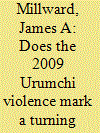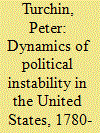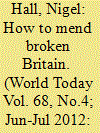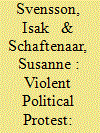|
|
|
Sort Order |
|
|
|
Items / Page
|
|
|
|
|
|
|
| Srl | Item |
| 1 |
ID:
103139


|
|
|
|
|
| Publication |
2009.
|
| Summary/Abstract |
To provide background for the four papers on Xinjiang and the Uyghurs in this special issue, this introduction discusses developments in the region since 1991, then outlines the events of June and July 2009 in Shaoguan, Guangdong, and Urumchi, Xinjiang, as best can be pieced together from available information. It concludes with brief introductions to the four articles on Xinjiang that follow in this special issue.
|
|
|
|
|
|
|
|
|
|
|
|
|
|
|
|
| 2 |
ID:
117020


|
|
|
|
|
| Publication |
2012.
|
| Summary/Abstract |
This article describes and analyses a database on the dynamics of sociopolitical instability in the United States between 1780 and 2010. The database was constructed by digitizing data collected by previous researchers, supplemented by systematic searches of electronic media archives. It includes 1,590 political violence events such as riots, lynchings, and terrorism. Incidence of political violence fluctuated dramatically over the 230 years covered by the database, following a complex dynamical pattern. Spectral analysis detected two main oscillatory modes. The first is a very long-term - secular - cycle, taking the form of an instability wave during the second half of the 19th century, bracketed by two peaceful periods (the first quarter of the 19th century and the middle decades of the 20th century, respectively). The second is a 50-year oscillation superimposed on the secular cycle, with peaks around 1870, 1920, and 1970. The pattern of two periodicities superimposed on each other is characteristic of the dynamics of political instability in many historical societies, such as ancient Rome and medieval and early-modern England, France, and Russia. A possible explanation of this pattern, discussed in the article, is offered by the structural-demographic theory, which postulates that labor oversupply leads to falling living standards and elite overproduction, and those, in turn, cause a wave of prolonged and intense sociopolitical instability.
|
|
|
|
|
|
|
|
|
|
|
|
|
|
|
|
| 3 |
ID:
123251


|
|
|
|
|
| Publication |
2012.
|
| Summary/Abstract |
Nigel Hall and Cat Tully point to the Victorian tricks that spread wealth.
|
|
|
|
|
|
|
|
|
|
|
|
|
|
|
|
| 4 |
ID:
107776


|
|
|
|
|
| Publication |
New Delhi, Routledge, 2011.
|
| Description |
viii, 186p.
|
| Standard Number |
9780415612548, hbk
|
|
|
|
|
|
|
|
|
|
|
|
Copies: C:1/I:0,R:0,Q:0
Circulation
| Accession# | Call# | Current Location | Status | Policy | Location |
| 056249 | 303.623/GUP 056249 | Main | On Shelf | General | |
|
|
|
|
| 5 |
ID:
095141


|
|
|
|
|
| Publication |
2010.
|
| Summary/Abstract |
Although diverse and extensive, scholarship on ethnic riots in South East Asia has given inordinate attention to the genesis, evolution and eventual suppression of such episodes of violence, while many of the available studies have been local in scope and have centred mainly on incidents in modern-day Indonesia and the Philippines. This paper takes as its point of departure some lacunae in the literature on ethnic riots in South East Asia. It seeks to initiate a shift from the study of the causes, processes and conditions that led to the outbreak of ethnic riots to a critical analysis of regional and global responses by both colonial and anticolonial actors in the aftermath. By focusing on the case of the deadly ethnic riots - commonly known as the Maria Hertogh riots - which broke out in Singapore in December 1950, and by drawing connections between local events and wider developments overseas, the paper demonstrates how the study of collective violence in South East Asia and elsewhere can be further enhanced through an analysis of the various strategies that were enacted by colonial states and by the forms of resistance and collaboration of the colonized and other non-state agencies.
|
|
|
|
|
|
|
|
|
|
|
|
|
|
|
|
| 6 |
ID:
031486


|
|
|
|
|
| Publication |
London, Royal United Service Institute For Defence Studies, 1975.
|
| Description |
156p.
|
|
|
|
|
|
|
|
|
|
|
|
Copies: C:1/I:0,R:0,Q:0
Circulation
| Accession# | Call# | Current Location | Status | Policy | Location |
| 015167 | 363.32/DEA 015167 | Main | On Shelf | General | |
|
|
|
|
| 7 |
ID:
123250


|
|
|
|
|
| Publication |
2012.
|
| Summary/Abstract |
Last August London was burning. MP David Lammy says vision
and ambition are needed to bring Tottenham back to life
|
|
|
|
|
|
|
|
|
|
|
|
|
|
|
|
| 8 |
ID:
187394


|
|
|
|
|
| Summary/Abstract |
This article presents the Uppsala Conflict Data Program (UCDP) “Violent Political Protest” (VPP) data set: a new –standalone- category of organized violence, which complements, and is compatible with, UCDP’s three categories of organized violence: one-sided violence, non-state, and state-based conflict. It consists of violent political protests, with at least 25 casualties during a year, in which informally organized civilians challenge states over governmental or territorial issues. We describe the data collection process, and demonstrate the data’s use with empirical analyses. Violent political protest is present globally, but most prevalent in the Middle East and Africa, and increasingly common over time. Violent political protest frequently co-occurs with state-based conflicts, but rarely due to conflict escalation. We explore if this is due to shared contexts, and find that gender inequality increases the likelihood of VPP onset, similar to state-based conflicts. Finally, we identify avenues for future research, including using VPP to assist in a more precise and complete analysis of organized violence.
|
|
|
|
|
|
|
|
|
|
|
|
|
|
|
|
|
|
|
|
|